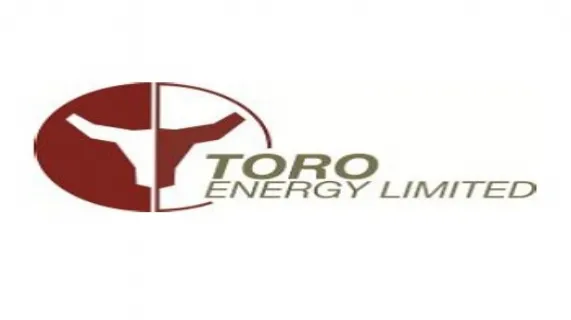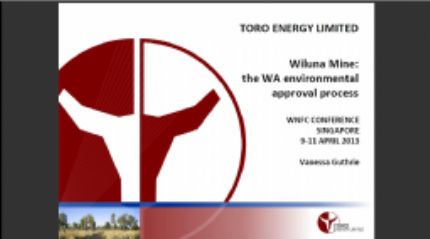
Maiden Inferred Uranium Resource for Toro's Theseus Deposit
Adelaide, Dec 5, 2012 AEST (ABN Newswire) - A maiden Inferred uranium resource has been announced by Toro Energy Limited ( ASX:TOE) for the Company's wholly owned Theseus deposit located in WA, near the NT border directly west of Alice Springs.
ASX:TOE) for the Company's wholly owned Theseus deposit located in WA, near the NT border directly west of Alice Springs.
The estimate, calculated at two different cut-off grades, refer to link below for table 1.
In addition, Toro has defined an updated Exploration Target Range (ETR) of:
28 - 35 Million tonnes of ISR Uranium at 450-520ppm U3O8 for 28Mlb to 40Mlb U3O8 (12,600t to 18,200t U3O8)#
Key points:
- The maiden Inferred Mineral Resource estimation was completed by Optiro Consultants using a categorical indicator kriging method based on gamma, PFN and core sample assays supplied by Toro.
- This initial sizeable resource was achieved despite limited drilling, and wide drill- hole spacing to ascertain mineralisation extent.
- The geological understanding of Theseus has been advanced with development of a new, early stage geological model, indicating lateral extent and structural controls.
- The revised ETR is defined by Toro covering the areas with limited or no drilling, with confidence in geological and topographic continuity that indicates probable extensions to the areas defined in the Inferred Mineral Resource.
- Toro is confident that future drilling can target the higher-grade uranium (>1000ppm) redox interfaces that will lift the average grade of the Theseus Deposit. Toro will also increase the overall footprint of the deposit through extension drilling.
Inferred Resource Estimation Work
At the request of Toro Energy, Optiro undertook an estimation of the Theseus Uranium Prospect.
The Theseus Prospect is located south of Lake Mackay in the Great Sandy Desert, in north-eastern Western Australia, shown on Figure 1.
A Categorical Indicator Kriging (CIK) approach was used for the estimate. Composite grades greater than 100ppm U3O8 were estimated into 100m x 100m x 1m blocks that had a greater than 0.4 probability of being within an interval wider than 0.5m and with a grade-thickness (GT) value greater than 500ppm GT. The composite grade values were generated from prioritised gamma (80%) and PFN (15%) readings and assay (5%) values in the database. The supplied gamma data had been deconvolved with an average disequilibrium factor of 1.4 applied to all readings.
Drill spacing is variable over the deposit: there are four areas at 100m x 100m spacing interspersed with 200m x 200m spacing. In the central area, drilling is mostly at 500m spacing, while in the southwest there is 600m between drill lines on which there are mineralised intersects. Drillhole locations coloured by GT values are shown on Figure 2.
At this level of drilling the broad uranium mineralisation at Theseus is considered to be up to 500m wide, sub-horizontal within horizons up to 10m thick, but averaging 3m thick and broadly trending WNW over nearly 10km. It remains open in a number of directions.
Toro compiled a single preferred U3O8 table for estimation and also supplied the drill hole summary table. The preferred U3O8 table allows for one uranium value per sample interval to be used in the estimation based on the following order of priority listed below:
1. Core assays.
2. PFN data above the 250ppm U3O8 detection limit and where the tool was shown to be operating correctly.
3. Deconvolved gamma data which had a disequilibrium factor of 1.4 applied to it and where the tool was shown to be operating correctly.
4. Aircore or mud rotary assays.
When the data sources were combined into a single 'pref U3O8' table it contained over 1.5 million readings; predominately from gamma sources. A summary of the data sources for the ''pref U3O8' is shown on Table 2.
Appendix 3 contains the drillhole summary table, listing drill hole details as Table 6 and the preferred U3O8 table, listed as Table 7.
Toro have interpreted each drillhole in the software program Wellcad using all available geophysical and geological logging.
A cross section example from the southern part of Thesus is shown as Figure 3. Changes in basement depth and associated increases in uranium mineralisation width and grade are noted in drillholes LM0174 and LM0187.
From this work, Toro has identified up to seven sand units above the basement and below a confining upper silcrete unit. Uranium mineralisation is generally located near the base of sand packages and transgresses unit boundaries. The lateral continuity of the broad mineralisation is well defined within palaeovalleys but the high-grade mineralisation is less defined and will require more infill drilling. Two confining wireframe surfaces were created to constrain the block model from the geological interpretation; above the basement, and below the upper silcrete layer.
The drilling and sampling density is appropriate to cover this broad mineralisation and for use in an ETR. In areas of detailed drilling in the north the mineralisation is more sinuous and narrow; the drilling density will need to be reduced in places to at least 100m x 100m to fully define the higher grade mineralisation, though the downhole sample spacing is still appropriate.
A composite length of 0.5m was selected as this is commonly accepted as the minimum width for economic extraction in an ISR deposit. For the CIK estimate, composites were selected within high-grade intervals which were determined using a MS Access and a VBA algorithm customised to eliminate external dilution and minimise internal dilution.
The block model was constrained between the basement and upper silcrete units and within a perimeter file that constrained the resource to the main WNW trending channel shown on Figure 2.
Mineral Resources have been classified on the basis of the drill spacing, geological confidence and data quality in accordance with the Australasian Code for Reporting of Identified Mineral Resources and Ore Reserves, 2004 (the JORC Code). The full 2012 Mineral Resource for the Theseus ISR Uranium Prospect at various cut offs is reported in Table 3.
Theseus Exploration Target Range
Toro is able to confirm the Exploration Target Range for Theseus and has revised it to 28-35 Million tonnes of ISR Uranium at 450-520ppm U3O8 for 28Mlb to 40Mlb U3O8 (12,600t to 18,200t U3O8)# based on the limited drilling of the fertile palaeovalley, extensions of known uranium mineralisation included in the Inferred Mineral Resource and the prediction of high grade (greater than 1% U3O8) in narrow sinuous zones that have not been intersected at the current drill density.
In announcing the release today, Toro Managing Director, Mr Greg Hall has stated:
"Toro is greatly encouraged by the confirmation of an initial Inferred Mineral Resource and the revision to the Exploration Target Range at Theseus. The next stage of drilling, planned for 2013, will be key to unlocking the full potential of this resource which has delivered high grade intersections geologically open in many directions. Key technical studies continue to highlight positive outcomes for a potential ISR uranium mine. Although early days, the confirmation of an Inferred Mineral Resource at Theseus opens up the "blue sky' of a new uranium province in Australia for Toro shareholders comparable to those in South Australia, Wyoming and Kazakhstan."
# CAUTIONARY STATEMENT: The Exploration Target Range is conceptual in nature and there has been insufficient exploration completed to define this material as a Mineral Resource. There is no certainty that the further work referred to herein will result in the determination of a Mineral Resource.
View the complete Toro Energy announcement including Tables and Figures at the link below:
http://media.abnnewswire.net/media/en/docs/ASX-TOE-710645.pdf
Contact
Toro Energy Limited
T: +61-8-8132-5600
F: +61-8-8362-6655
WWW: www.toroenergy.com.au
| ||
|









